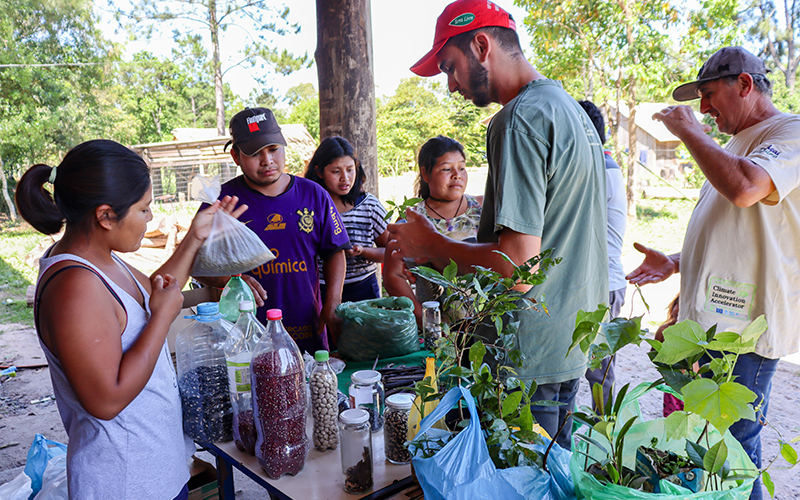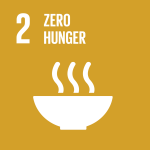
This article was authored by the Adaptation Fund and first published on the Adaptation Fund website here.
Designing adapted agricultural systems that combine sustainable food production, income generation, and environmental protection is critical to transforming food systems. In climate-vulnerable tropical countries, adaptation solutions often need to be tailored further to meet social complexities and ecological imperatives.
A project in Southern Brazil is doing just that.
Although Brazil is one of the leading countries in exporting agricultural commodities, more than half of the population -- approximately 116 million Brazilians -- live with some degree of food insecurity. Estimates point to 43.4 million people not having enough food, and 19 million facing hunger, per a study published by the Penssan network in 2021. The COVID-19 pandemic aggravated the situation further through heavy job losses.
Through the innovative project, Brazil is responding to these challenges by adopting agricultural adaptation strategies and implementing complex agroforestry systems that foster income generation while preserving forests and their biodiversity. A primary goal is advancing the production-to-consumption chain of agroecological foods, notably the unique bitter-tasting açaí berry fruit derived from the juçara palm—a native endangered species.
Traditionally, açaí was used as a staple food for centuries in the Amazon basin. The thrust of the project is using a plant of the same category, Euterpe edulis, commonly known as juçara typically found in the Atlantic Forest biome that runs along Brazil’s eastern coast, to produce a similar food. The resilient species is critically important in the design of food production adaptation strategies, especially when combined with other trees in complex agroforestry systems, and is having a significant impact.

Sharing seeds and vegetable garden workshop at Nhu Pora indigenous land in Torres, Rio Grande do Sul, Brazil. Photo: Tiago Meirelles
Funded by the Adaptation Fund Climate Innovation Accelerator (AFCIA), the project is implemented by Centro Ecológico in Brazil and is empowering family farmers –especially women, youth, and indigenous peoples--to develop and implement local agricultural adaptation strategies to enhance the açaí berry production chain. Launched by the Adaptation Fund (AF) to accelerate piloting and scaling up of innovative adaptation projects to help address urgent adaptation needs in developing countries and vulnerable communities, AFCIA is a growing partnership between the AF, European Union, UNDP, UNEP-CTCN, UNIDO and World Food Programme. AFCIA grants are available to a broad range of stakeholders, from local governments to NGOs, community groups, entrepreneurs, young innovators and others. The project in Brazil was supported by the UNDP-AFCIA programme, administered by UNDP and funded by the AF and EU, which has awarded 44 grants to local innovators and organizations in 33 countries since 2022.
It is already making a difference. The Brazil project has led to a significant increase in family incomes resulting from local sales of açaí juçara. Some families have managed to harvest up to two tons of fruits annually, translating to a yearly income of about $2,000 from these sales.
One of the biggest achievements of the project has been its approach towards engaging indigenous communities and empowering them to lead. The project has played a vital role in fortifying the Mbya Guarani communities on Guyra Nhendu indigenous land, along the northern coast of the Rio Grande do Sul River system, and recovering degraded areas through the planting of tree species and implementing sustainable agroforestry strategies. Although agroforestry had been an intrinsic facet of the Guarani culture previously, they encountered challenges in obtaining efficient equipment to scale up production. The project supported communities in accessing the needed agricultural equipment and even went beyond that, forging new partnerships and rallying community support in the process.
“Thanks to this project, we have not only established avenues for market sales in towns but also secured sustenance for our families and communities. This support has extended beyond our village, Guyra Nhendu, reaching neighboring villages,” said Hélio Wherá, an indigenous community leader from Guyra Nhendu indigenous land, who is the Indigenous coordinator for the project.
The initiative builds on the Guarani people’s values of sharing food and reverence for the agroforestry system. The project further holds workshops with women and young people from other indigenous lands to promote cross learning and sharing.
“Youngsters from other communities are now actively participating in workshops, learning to harvest juçara palm fruits and make açaí. They leave the stored açaí here and return later to prepare juice or smoothies for consumption. During our meetings and gatherings, juçara açaí has become quite popular, [and an effective adaptation solution],” Wherá adds.
Many families have encouraged younger family members to participate in the activity, enabling them to benefit from sustained incomes generated by marketing juçara. Moreover, the project is working as a model for similar interventions located in the Atlantic Forest region of Brazil.
The project is also raising environmental awareness by linking local schools to an environmental education program called‘Juçara Goes to Schools’. It promotes the juçara palm tree within the school environment, increases inclusion of açaí juçara in school meals; and encourages schools to include açaí juçara in their menus. To date, the project has implemented activities in six schools across four municipalities, directly impacting approximately 674 students. The project’s impact extends beyond the classroom, reaching students’ families and the broader community.
It has empowered women to take on leadership roles in the açaí juçara production chain. This has proven to be instrumental in improving production processes in almost all consorted plantations and backyard gardens. Women are taking on roles in planning, organization, and cultivation of juçara fruit, and extending their contributions beyond culinary events, encompassing educational activities and guided tours that raise awareness and foster appreciation for juçara among both visitors and local communities alike.
Anelise Becker Vieira, a female farmer from the Morro Azul family agro-business, said, “The project has established our agroindustry as a significant player in this domain. We believe that the juçara cycle, spanning from field production to agroindustry processing, not only generates income for farming families but also contributes to environmental conservation. Centro Ecológico’s support through this AFCIA project has been invaluable in expanding our network to include more farming families. Together, we are increasingly championing the Juçara culture, which holds significant environmental and social importance.”




